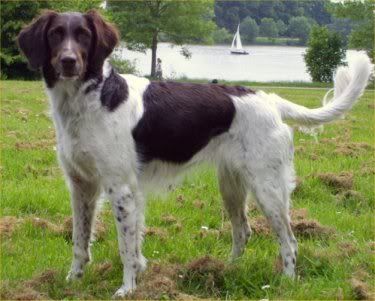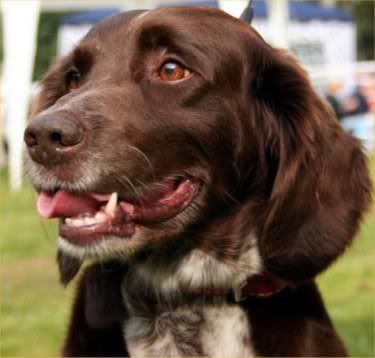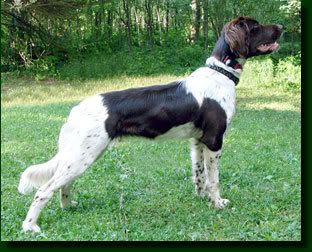Post by charmingnancy on Jan 20, 2009 16:46:33 GMT -5
Kleiner Münsterländer
Group: 1- Sporting
Origin: Munster, Germany
Purpose: Originally a dog bred to work with noble families' falconers before guns were used in bird and small game hunting, ancestors of the Small Munsterlander had to work in upland areas to flush prey for the falcon, then allow the falcon to keep the prey until the falconer could retrieve it while the dog pointed at the catch.

Description:
Known as Kleiner Münsterländer Vorstehund, the Small Münsterländer Pointer was developed in the early 1900s in Munster, Germany. He is a courageous and tireless hunter with excellent retrieving skills. The Munsterlander is a very versatile hunting dog with great pointing and retrieving abilities, and therefore, loves to hunt as well as swim. In Europe, he is used to track, point and retrieve upland birds, waterfowl and fur-bearing animals and he has also been used to hunt deer and boar.
Appearance- Breed Standards:
Coat & Colour:
Coat- Hair: Dense, of medium length, not or only slightly wavy, close lying, water repellent. The outlines of the body may not be hidden by too long coat. By its density it should provide as good protection against weather, unfavourable terrain conditions and injuries as possible. Short smooth coat and on the ears is faulty. Forelegs feathered hindlegs with breeching down to the hocks, tail with a long flag and white tip, abundant coat on the forechest is undesirable. Skin: Tight fitting, without folds.
Colour- Brown-white or brown roan with brown patches, brown mantle or brown ticking; blaze permitted. Tan coloured markings at the muzzle, the eyes and around the anus are permissible (“Jungklause markings”).
Head: The expression of the head is part of the type. Skull: Distinguished, lean, flat to slightly arched. Stop: Only slightly pronounced but distinctly recognizable. Nose: Wholecoloured brown. Muzzle: Powerful, long, straight. Lips: Short, tight closing, well pigmented-wholecoloured brown. Jaws/Teeth: Large white teeth. Powerful jaws with regular and complete scissor bite with the upper teeth closely overlapping the lower teeth and set square to the jaws. 42 teeth according to the dentition formula. Cheeks: Strong, well muscled. Eyes: Of medium size, neither protruding nor deep set. As dark brown as possible. Eyelids tight fitting to the eyeballs, covering the haws. Ears: Broad, set on high, lying close to the head, tapering towards the tips, ear leather should not reach beyond the corner of the mouth.
Neck: Its length in balance with the general appearance; gradually towards the body. Napeline slightly arched, very muscular. Tight fitting throat skin.
Forequarters: Viewed from the front straight and rather parallel, viewed from the side legs set well under the body. The distance from the ground to the elbows should approximately equal to the distance from the elbows to the withers. Shoulder blades lying close to the body, strongly muscled. Shoulder and upperarm forming a good angle of approximately 90 degrees. Upper arm: As long as possible, well muscled. Elbows: Close to the body, neither turning in nor out. The upper arm forming a good angle with the forearm. Forearm: Strong bones, perpendicular to the ground. Carpal joint: Strong. Pasterns: Very slightly sloping. Front feet: Round and arched with well knit toes and sufficiently thick, tough, robust pads. Not too heavy coat. Parallel in stance or in movement, neither tuning in nor out.
Body: Topline: Slightly sloping in a straight line. Withers: Pronounced. Back: Firm, well muscled. The spinal processes should be covered by the musculature. Loins: Short, broad, muscular. Croup: Long and broad, not short slanting, only slightly sloping towards the tail; well muscled. Broad pelvis. Chest: Rather deep than broad, breastbone reaching as far backwards as possible. Ribs well arched. Underline and belly: Slight tuck-up towards the rear in an elegant curve; lean.
Hindquarters: Viewed from the rear straight and parallel. Correct angulation in stifles and hocks. Strong bones. Upper thigh: Long, broad, muscular; forming a good angle with the pelvis. Stifle: Strong, upper and lower thigh forming a good angle. Lower thigh: Long, muscular and sinewy. Hock joint: Strong. Metatarsus: Short, perpendicular to the ground. Hind feet: Round and arched with well knit toes and sufficiently thick, tough, robust pads; not too heavy coat. Parallel in stance or in movement neither turning in nor out.
Tail: Set on high, with long flag, strong at the base, then tapering. Of medium length. Carried downwards in repose, horizontally and not too high above the level of the topline with a slight sweep when in action. In the lower third it may be curved slightly upward.
Gait: Ground covering, with good drive and appropriate reach, straight forward and parallel coming and going, with well upstanding posture. Pacing gait is undesirable.
Faults: Any departure of the foregoing points must be considered a fault and the seriousness with which the fault should be regarded should be in exact proportion to its degree
Severe Faults: Deviation of the size limits between +/- 2 cm (.79 inches) and +/- 4 cm (1.57 inches); Clumsy, big-boned conformation; Serious deviations from the correct proportions of body, neck and height and withers; More than 50% of the nose flesh-coloured or spotted; Pointed muzzle; Dished nose bridge; Eyes too light; Light yellow hawk eyes; Serious lack of depth of chest or too flat sided brisket; Barrel shaped brisket; Elbows heavily turning out or in; Steep pasterns; Strongly cow hocked or barrel legged, in stance as well as in movement; Splayed toes; flat feet; Clumsy movement; Coat too curled; Smooth hairless ears or too long and curled fringes on the ears.
Disqualification: Fearfulness, aggressiveness, game or gun shyness; Size deviation of more than +/- 4 cm (1.57 inches); Untypical sexual characteristics, sexual malformations; Completely depigmented nose; All deviations from the correct scissor bite except the lack or excess of two P1; Split jaw or split lip; Ectropion, entropion, distichiasis, bird’s eye; Pronounced dewlap; Distinct roach back, swayback; crooked spine; Malformation of the ribcage, such as sternum cut off; Kinky tail, ring tail, other tail abnormalities like too short or too long; Wholecoloured dogs; Any dog clearly showing physical or behavioural abnormalities shall be disqualified.
Size:
The breed is often described as about 35 pounds (16 kg) and 18-20 inches (0.45 to 0.5 m) at the shoulder, but the average is somewhat larger, around 45 pounds (20 kg) with some males reaching or slightly exceeding 60 pounds (27 kg) and up to 22 inches (0.55 m).

Temperament:
Small Munsterlanders are very intelligent, trainable, and attentive but require gentle and patient training, which provides excellent results. They are also strong-willed and an owner who is inconsistent or indecisive might find that his dog is hard to control. Both voice and hand signals are used, and an SM looks back at the hunter for silent signals at intervals when on hold or pointing. They have a very strong drive to follow their keen sense of smell, and thrive with hunting or comparably challenging exercise for an hour or more every day.
Health:
There have been a few instances of hip dysplasia. This breed is very healthy.
Average Lifespan:
13 - 15 years.
History:
Similar and related variety of the Large Münsterländer, the small Münsterländer is a 20th century creation from old type Spanish type Spaniels. The Kleiner Münsterländer was developed in Westphalia, Germany from small gundogs related to the German Longhaired Pointer and Dutch, French and Spanish gundogs. The breed was discovered by Herr Edmund Löns who recognized it’s above average abilities and worked towards the establishment of a parent club in 1912.
The Small Munsterlander is rare in the United States, numbering perhaps in the hundreds, and demand from hunters outstrips the number of available dogs, so breeders typically give preference to hunters. They're especially hard to come by for nonhunters there. They are more numerous in Germany, the Netherlands, and the Czech Republic. SMs excel in nonhunting roles as well because of their exceptional scent-tracking ability, and are used in search and rescue teams and contraband detection ("drug sniffing") roles as well.
In the United Kingdom, the breed is rarer still, with less than 30 dogs known. Recognised by The Kennel Club as an imported breed in 2006, they are still to be established in the hunting community.
Other names for this breed: Spion in Germany; and Heidewachtel in the Netherlands.

Sources:
Canada's Guide to Dogs
CKC
Wikipedia
Puppydog Web
Pictures:
Photobucket
Group: 1- Sporting
Origin: Munster, Germany
Purpose: Originally a dog bred to work with noble families' falconers before guns were used in bird and small game hunting, ancestors of the Small Munsterlander had to work in upland areas to flush prey for the falcon, then allow the falcon to keep the prey until the falconer could retrieve it while the dog pointed at the catch.

Description:
Known as Kleiner Münsterländer Vorstehund, the Small Münsterländer Pointer was developed in the early 1900s in Munster, Germany. He is a courageous and tireless hunter with excellent retrieving skills. The Munsterlander is a very versatile hunting dog with great pointing and retrieving abilities, and therefore, loves to hunt as well as swim. In Europe, he is used to track, point and retrieve upland birds, waterfowl and fur-bearing animals and he has also been used to hunt deer and boar.
Appearance- Breed Standards:
Coat & Colour:
Coat- Hair: Dense, of medium length, not or only slightly wavy, close lying, water repellent. The outlines of the body may not be hidden by too long coat. By its density it should provide as good protection against weather, unfavourable terrain conditions and injuries as possible. Short smooth coat and on the ears is faulty. Forelegs feathered hindlegs with breeching down to the hocks, tail with a long flag and white tip, abundant coat on the forechest is undesirable. Skin: Tight fitting, without folds.
Colour- Brown-white or brown roan with brown patches, brown mantle or brown ticking; blaze permitted. Tan coloured markings at the muzzle, the eyes and around the anus are permissible (“Jungklause markings”).
Head: The expression of the head is part of the type. Skull: Distinguished, lean, flat to slightly arched. Stop: Only slightly pronounced but distinctly recognizable. Nose: Wholecoloured brown. Muzzle: Powerful, long, straight. Lips: Short, tight closing, well pigmented-wholecoloured brown. Jaws/Teeth: Large white teeth. Powerful jaws with regular and complete scissor bite with the upper teeth closely overlapping the lower teeth and set square to the jaws. 42 teeth according to the dentition formula. Cheeks: Strong, well muscled. Eyes: Of medium size, neither protruding nor deep set. As dark brown as possible. Eyelids tight fitting to the eyeballs, covering the haws. Ears: Broad, set on high, lying close to the head, tapering towards the tips, ear leather should not reach beyond the corner of the mouth.
Neck: Its length in balance with the general appearance; gradually towards the body. Napeline slightly arched, very muscular. Tight fitting throat skin.
Forequarters: Viewed from the front straight and rather parallel, viewed from the side legs set well under the body. The distance from the ground to the elbows should approximately equal to the distance from the elbows to the withers. Shoulder blades lying close to the body, strongly muscled. Shoulder and upperarm forming a good angle of approximately 90 degrees. Upper arm: As long as possible, well muscled. Elbows: Close to the body, neither turning in nor out. The upper arm forming a good angle with the forearm. Forearm: Strong bones, perpendicular to the ground. Carpal joint: Strong. Pasterns: Very slightly sloping. Front feet: Round and arched with well knit toes and sufficiently thick, tough, robust pads. Not too heavy coat. Parallel in stance or in movement, neither tuning in nor out.
Body: Topline: Slightly sloping in a straight line. Withers: Pronounced. Back: Firm, well muscled. The spinal processes should be covered by the musculature. Loins: Short, broad, muscular. Croup: Long and broad, not short slanting, only slightly sloping towards the tail; well muscled. Broad pelvis. Chest: Rather deep than broad, breastbone reaching as far backwards as possible. Ribs well arched. Underline and belly: Slight tuck-up towards the rear in an elegant curve; lean.
Hindquarters: Viewed from the rear straight and parallel. Correct angulation in stifles and hocks. Strong bones. Upper thigh: Long, broad, muscular; forming a good angle with the pelvis. Stifle: Strong, upper and lower thigh forming a good angle. Lower thigh: Long, muscular and sinewy. Hock joint: Strong. Metatarsus: Short, perpendicular to the ground. Hind feet: Round and arched with well knit toes and sufficiently thick, tough, robust pads; not too heavy coat. Parallel in stance or in movement neither turning in nor out.
Tail: Set on high, with long flag, strong at the base, then tapering. Of medium length. Carried downwards in repose, horizontally and not too high above the level of the topline with a slight sweep when in action. In the lower third it may be curved slightly upward.
Gait: Ground covering, with good drive and appropriate reach, straight forward and parallel coming and going, with well upstanding posture. Pacing gait is undesirable.
Faults: Any departure of the foregoing points must be considered a fault and the seriousness with which the fault should be regarded should be in exact proportion to its degree
Severe Faults: Deviation of the size limits between +/- 2 cm (.79 inches) and +/- 4 cm (1.57 inches); Clumsy, big-boned conformation; Serious deviations from the correct proportions of body, neck and height and withers; More than 50% of the nose flesh-coloured or spotted; Pointed muzzle; Dished nose bridge; Eyes too light; Light yellow hawk eyes; Serious lack of depth of chest or too flat sided brisket; Barrel shaped brisket; Elbows heavily turning out or in; Steep pasterns; Strongly cow hocked or barrel legged, in stance as well as in movement; Splayed toes; flat feet; Clumsy movement; Coat too curled; Smooth hairless ears or too long and curled fringes on the ears.
Disqualification: Fearfulness, aggressiveness, game or gun shyness; Size deviation of more than +/- 4 cm (1.57 inches); Untypical sexual characteristics, sexual malformations; Completely depigmented nose; All deviations from the correct scissor bite except the lack or excess of two P1; Split jaw or split lip; Ectropion, entropion, distichiasis, bird’s eye; Pronounced dewlap; Distinct roach back, swayback; crooked spine; Malformation of the ribcage, such as sternum cut off; Kinky tail, ring tail, other tail abnormalities like too short or too long; Wholecoloured dogs; Any dog clearly showing physical or behavioural abnormalities shall be disqualified.
Size:
The breed is often described as about 35 pounds (16 kg) and 18-20 inches (0.45 to 0.5 m) at the shoulder, but the average is somewhat larger, around 45 pounds (20 kg) with some males reaching or slightly exceeding 60 pounds (27 kg) and up to 22 inches (0.55 m).

Temperament:
Small Munsterlanders are very intelligent, trainable, and attentive but require gentle and patient training, which provides excellent results. They are also strong-willed and an owner who is inconsistent or indecisive might find that his dog is hard to control. Both voice and hand signals are used, and an SM looks back at the hunter for silent signals at intervals when on hold or pointing. They have a very strong drive to follow their keen sense of smell, and thrive with hunting or comparably challenging exercise for an hour or more every day.
Health:
There have been a few instances of hip dysplasia. This breed is very healthy.
Average Lifespan:
13 - 15 years.
History:
Similar and related variety of the Large Münsterländer, the small Münsterländer is a 20th century creation from old type Spanish type Spaniels. The Kleiner Münsterländer was developed in Westphalia, Germany from small gundogs related to the German Longhaired Pointer and Dutch, French and Spanish gundogs. The breed was discovered by Herr Edmund Löns who recognized it’s above average abilities and worked towards the establishment of a parent club in 1912.
The Small Munsterlander is rare in the United States, numbering perhaps in the hundreds, and demand from hunters outstrips the number of available dogs, so breeders typically give preference to hunters. They're especially hard to come by for nonhunters there. They are more numerous in Germany, the Netherlands, and the Czech Republic. SMs excel in nonhunting roles as well because of their exceptional scent-tracking ability, and are used in search and rescue teams and contraband detection ("drug sniffing") roles as well.
In the United Kingdom, the breed is rarer still, with less than 30 dogs known. Recognised by The Kennel Club as an imported breed in 2006, they are still to be established in the hunting community.
Other names for this breed: Spion in Germany; and Heidewachtel in the Netherlands.

Sources:
Canada's Guide to Dogs
CKC
Wikipedia
Puppydog Web
Pictures:
Photobucket

